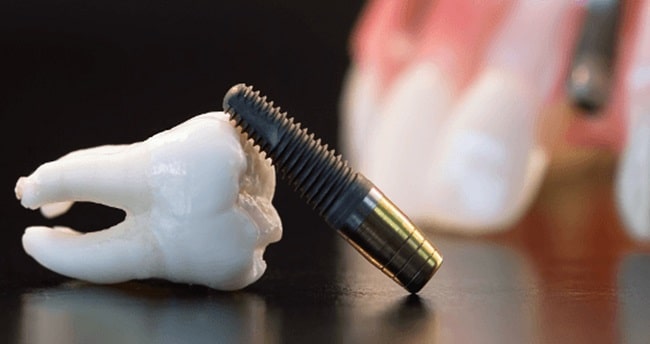If one or more of your teeth are missing, there are a number of ways to replace them. An alternative to bridges, partials or complete dentures may be dental implants. Implants are used to replace missing roots and support artificial replacement teeth. They are comfortable and look like natural teeth.
Who can get dental implants?
If you are in good general health, have healthy gums and have enough bone in the jaw to hold an implant, dental implants might be right for you. If your jawbone has shrunk or if it has not developed normally, you may be able to have a bone graft to build up the bone. A bone graft is a way of adding new bone to your jawbone. Your dentist or dental specialist will tell you if bone grafting can be done.
Types of dental implants
There are two major types of dental implants:
In the bone implants
In the bone (Endosteal) implants are the most common type of dental implant. They usually resemble small screws. Endosteal implants are made from body-safe materials, such as titanium. Endosteal implants are surgically inserted deep into the jawbone where they take the place of tooth roots. One implant can be used to anchor one or several teeth.
On the bone implants
This type of implant is used when there’s not enough healthy jawbone available to support an endosteal implant. On the bone implants are inserted under the gum but aren’t drilled into the jawbone. They are placed above or on the bone, rather than in it.
Dental implant materials
Dental implants can be made from a few different materials. Each material affects an implant’s price and has unique advantages.
Most dental implants are made from titanium or zirconia:
Titanium implants
Titanium has long been used for hip or knee replacements because it fuses well with bone. The metal has been time-tested to be a successful and long-lasting option for dental implants. It’s strong and durable, yet lightweight. Some people aren’t good candidates for titanium implants because of allergies or autoimmune disease.
Zirconia implants
Zirconia is a metal-free crystal material that is fairly new to being used in dental implants. The one-piece construction of zirconia makes for a shorter surgery when compared to titanium’s three pieces. There’s also no chance that zirconia could agitate a metal allergy. Because zirconia implants are newer, there isn’t as much evidence to support how long-lasting they might be. In addition, zirconia implants are more expensive than titanium options.
Dental implant procedure
How your dentist performs the dental procedure depends on the implant you need, if you have any allergic reaction, and the condition of the jawbone. You may have to have several dental procedures so that your bone can heal properly around the implant. This healing could take time but will support the new tooth securely.
Initial Evaluation
Your dentist or oral surgeon will first do a comprehensive examination to determine the best to determine the condition of your jawbone and the best dental implant procedure. This initial evaluation includes X-rays, taking impressions, and matching the color of your teeth to make your implant look as natural as possible. You will determine how many teeth you want to replace with implants, which could take some additional planning with other dental specialists, like periodontists, depending on your oral health condition.
Tooth Extraction
If you still have a remaining tooth that needs replacing, your dentist will remove it before the dental work is performed. You can have this done at the same time as the implant insertion.
Inserting the Dental Implant and Bone Grafting
Depending on what type of dental implant you choose dental implant is ether inserted in the jawbone or goes under your gum line.
If your current jawbone is strong and thick enough, you may not need to get any extra bone added. Your jaw needs to be strong because there is a lot of pressure when you chew, and you need your bone to be strong to protect that implant. If your jaw needs some extra bone, this bone typically comes from another area of your jawbone away from the implant area.
Installing the Abutment
After the implant is fully integrated, the abutment is installed. It connects the replacement tooth, or implant crown, to the implant.
Minor surgery to open up the gums is required to place the abutment. It is an outpatient procedure that only needs a local anesthetic. Once the abutment is in position, the gum tissue will be closed around it but not cover it. Still, there are instances wherein both the implant and the abutment are installed in one surgery process.
Fitting the Crown
After taking fresh dental impressions, your dental surgeon will shape the replacement tooth to fit your existing tooth structure.
After the swelling in your mouth has gone down, you will have an appointment with your dentist again for the new crown. The first step is for them to take impressions of your mouth that they can use to create the fake tooth that would go onto the abutment.
People who want to maintain a natural appearance may consider selecting the same color for their crown to match the other natural teeth.
Risks of Surgery
If you need to replace a tooth, implant surgery is considered a safe procedure. Complications come up if you have certain medical conditions or smoke. Talk to your dental professional about your health history and discuss any potential risks. Some risks include:
- Implant infection
- Injury to other teeth or blood vessels
- Nerve damage with pain, a tingling or numb sensation to your gums, chin, or lips
- When implants are in the upper jaw, this can cause sinus problems
Dental implant success
Patients have reported that having dental implants can be far less painful than having a tooth removed or root canal treatment. The placement of dental implants is generally easier than most people imagine. It is one event in a very well planned, organised process. This means that aftercare and healing is also usually straightforward and uneventful.
Your commitment to your implant treatment outcome is that you maintain good oral hygiene. Cleaning your implants is not difficult and once your dentist is satisfied your treatment is going well, ongoing care will be similar to any patient with natural teeth.
FAQs
Will I experience pain after implant placement?
Usually there is little pain after the implant placement. Often none or just a couple of pain control tablets are needed on the day after the procedure. Some swelling as well as bruising for a few days after surgery can also be expected.
How often do I need to visit my dentist after implant placement?
For the first few months your dentist may ask that you are seen more frequently; however, once they are satisfied your treatment is performing as planned, ongoing care will be similar to any patient with natural teeth.
What is peri-implant disease?
Peri-implant mucositis is inflammation in the gums around the implants. Plaque needs to be removed regularly, or it can build up, especially along the gum line, and cause redness and swelling.
For more useful dental implant aftercare tips, contact the experts at Mission Dental Implant Centre today on 949-364-2935.




